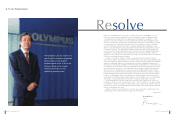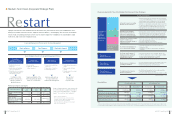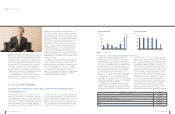Olympus 2013 Annual Report Download - page 17
Download and view the complete annual report
Please find page 17 of the 2013 Olympus annual report below. You can navigate through the pages in the report by either clicking on the pages listed below, or by using the keyword search tool below to find specific information within the annual report.
30 OLYMPUS Annual Report 2013 31OLYMPUS Annual Report 2013
Review of Business Segments
(Millions of yen)
Years ended March 31 2011 2012 2013
Operating Results
Net Sales 355,322 349,246 394,724
Operating Expenses 283,640 281,058 307,655
Operating Income 71,682 68,188 87,069
Operating Margin (%) 20.2 19.5 22.1
Sales by Product
Endoscopes 195,459 191,798 218,674
Domestic 43,848 43,803 47,335
Overseas 151,611 147,995 171,339
Surgical & Endotherapy 159,863 157,448 176,050
Domestic 35,582 36,615 42,177
Overseas 124,281 120,833 133,873
Segment Data
R&D Expenditures (¥ Billion) 28.5 26.9 31.3
Capital Expenditures (¥ Billion) 15.5 15.6 17.1
Number of Employees* 15,646 16,225 16,552
* Including average number of temporary employees
Olympus developed the world’s fi rst practical gastrocamera in 1950, contributing signifi cantly to the establishment of a
method for the early diagnosis of gastric cancer, the leading cause of death in Japan at the time. Subsequently, we have
worked to develop a wide variety of detection and treatment methods using endoscopes and endoscopic devices.
Today, the trend toward minimally invasive treatment is revolutionizing medical care. Surgery that previously required opening
the abdominal cavity can now be performed through the use of an endoscope, which enters the body through a natural orifi ce
or small incision in the skin, resulting in nearly undetectable scars. These breakthroughs in minimally invasive procedures have
helped reduce the physical burden on patients and have contributed to overall improvements in the quality of life.
Main Areas and Products
Composition (Fiscal year ended March 31, 2013)
Gastrointestinal Endoscopes
Endoscopy systems:
Videoscopes, video processors, light
sources, liquid crystal display (LCD)
panels, etc.
Peripheral equipment:
Image recording device, endoscope
cleaning systems, sterilization systems, etc.
Surgical Devices
Medical equipment for surgical
therapy and surgery:
Surgical video endoscopy systems
(surgical endoscopes, video processors,
light sources, LCD panels, etc.),
peripheral devices for endoscopic
surgery, electrosurgical knives, etc.
Endotherapy Devices
Endoscopic devices for all disciplines
of endoscopy:
Approximately 1,000 different devices
for various diagnostic and treatment
procedures, including biopsy forceps,
high-frequency polypectomy snares,
grasping forceps, stone retrieval and
lithotriptor baskets, hemostasis
accessories, etc.
Share of
Net Sales
(Consolidated net sales)
53.1%
Share of
Net Sales
by Product
Japan
22.7%
Others
2.6%
North America
34.9%
Europe
26.0%
Asia /
Oceania
13.8%
Share of
Net Sales
by Region
e
e
e
nts
Endoscopes
55.4%
Surgical &
Endotherapy
44.6%
MEDICAL
BUSINESS
Universal upper
digestive video-
scope (Gastrointes-
tinal videoscope)
Laparoscope
(Surgical endoscope)
ITknife nanoTM
disposable,
high-frequency knife
(Endotherapy device)
EVIS LUCERA ELITE
(Video endoscopy system)
THUNDERBEAT (integrated with both
Advanced Bipolar and Ultrasonic Energy)
Grasping forceps (Endotherapy device)
























